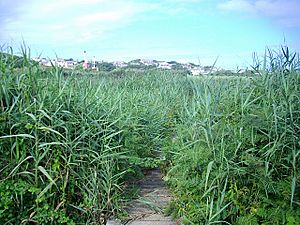Lower Moors (St Mary's) facts for kids
| Site of Special Scientific Interest | |

The wetlands of Lower Moors
|
|
| Area of Search | Cornwall |
|---|---|
| Coordinates | 49°54′59″N 6°18′09″W / 49.9164°N 6.3025°W |
| Interest | Biological |
| Area | 10.2 hectares (0.10 km2; 0.039 sq mi) |
| Notification | 1971 |
The Lower Moors is a special wetland area. It's found on St Mary's, the biggest island in the Isles of Scilly. You can find it between Hugh Town and Old Town Bay. The Isles of Scilly are a group of islands (an archipelago) located off the southwest coast of Cornwall in Great Britain.
The Isles of Scilly Wildlife Trust looks after this area. It's also part of the beautiful Isles of Scilly Area of Outstanding Natural Beauty. Lower Moors became a Site of Special Scientific Interest (SSSI) in 1971. This means it's a very important place for nature. It has many different wetland habitats.
This wetland is a key feeding spot for birds that are migrating or spending the winter. Birds like the common snipe and water rail come here. In 2007, a rare bird called a great blue heron was seen here by Cavell Smith. This was the first time this bird was officially recorded in Britain. Later, a second great blue heron was also seen at Lower Moors, again by Cavell Smith.
Exploring the Lower Moors Wetland
Lower Moors is one of two wetlands on St Mary's. It's a Site of Special Scientific Interest because of its many wetland habitats. It's also a vital place for birds that are passing through or staying for winter. The marsh gets its water from underground and small streams. This creates small pools, wet areas (called mires), and areas with willow trees.
In the past, the marsh stretched from Old Town Bay to Porthloo Pool. Even in the 1960s, there were wet fields near Porthloo Pool and Rose Hill. These fields had plants like hemlock water-dropwort (Oenanthe crocata), lesser water-plantain (Baldellia ranunculoides), and yellow iris (Iris pseudacorus). Today, these fields are much drier. The lesser water-plantain hasn't been seen on the Isles of Scilly since the year 2000.
You can enter Lower Moors from a short path at Old Town. Old Town was the first main settlement on St Mary's long ago. You can also get there from the A3111 road near Porth Mellon. The ground here is wet, made of alluvium (river deposits) and peat (decayed plant matter). Underneath this is hard granite rock.
Since animals stopped grazing here, some parts of the marsh have become overgrown. You'll find lots of common reed (Phragmites australis), rushes (Juncus sp), and grey willow (Salix cinerea). Drainage ditches flow south towards Old Town Bay. These ditches divide the marsh into wet meadows. These meadows have plenty of soft rush (Juncus effusus), yellow iris, and some ragged robin (Lychnis flos-cuculi) and greater bird’s-foot trefoil (Lotus pedunculatus). Drier areas are mostly covered by bramble (Rubus fruticosus) and bracken (Pteridium aquilinum).
Birds and Wildlife at Lower Moors
Lower Moors is an important feeding ground for many birds that live here all the time. These include birds like the Eurasian coot, gadwall, mallard, common moorhen, Eurasian teal, and various warblers. The small open water areas are key for migrating snipe and water rail. The reed beds and wet meadows are used by birds such as the corncrake and spotted crake.
A type of grasshopper called the short-winged cone-head was first recorded on St Agnes in 1989. It was confirmed in 1992 and then found at Lower Moors in 1996. It's thought that their eggs might have floated to the islands on plants carried by the sea. This means they could have been living on Scilly even before 1989.
The Rare Great Blue Heron Sightings
Many bird watchers visit the Isles of Scilly hoping to see rare birds. These are often birds that have flown off course during their migration. The first time a great blue heron was officially seen in Britain was on December 7, 2007. Cavell Smith spotted it at Lower Moors. This sighting was then added to the official list of British birds.
On April 14, 2015, Cavell Smith saw two herons from the bird-hide at Lower Moors. One was a common grey heron, and the other was another great blue heron. This was the second time this rare bird was seen in Britain. After this, the bird was also seen at Old Town Bay, on Tresco, and on Bryher. Before these sightings, two other great blue herons had been seen in Britain, but they had arrived on ships.


